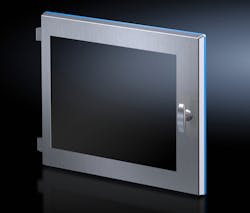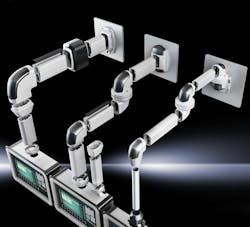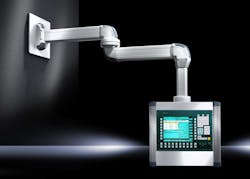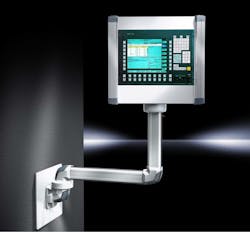Tips for Selecting and Positioning Industrial HMIs and Control Panels
For smart industrial facilities to operate effectively, engineers and designers must consider the control panels and HMIs (human-machine interfaces), and where to place them on the factory floor and elsewhere. While everyone is aware of what control panels are, the term HMIs encompasses more than most would think, including everything from handles to keyboards to pillar lighting and even electrical plugs. However, there are some common considerations engineers and designers should make when developing and deploying both.
When specifying control panels and HMIs, engineers should address the application, the environment, ratings and certifications, ergonomics and monitoring capabilities.
The Application
Engineers often overlook application-specific details when dealing with control panels and HMIs. All too often they focus on the machinery and equipment while ignoring where they will operate.
A machine’s HMIs directly affect the operator’s job. HMIs must be accessible from safe locations. This means mounting them so operators won’t have to stand in an aisle or near unsafe machinery to reach them. Designing machines with several mounting options for HMIs and control panels is a good idea if the machine’s exact location in the factory is unknown. For example, putting keyboards, touchscreens and other controls on support arms that swing, swivel and adjust to keep operators safe and comfortable keeps all options open.
Similarly, line of sight is important on both the machine and facility level. Ensure HMIs get placed where they do not impair an operator’s ability to visually inspect the machine or products. Will the operator have to stoop, bend, stretch or move into an unsafe space to carry out required visual assessments? Does the HMI have to be frequently moved for the operator to perform normal functions of their job? Will the HMI’s location get in the way of normal maintenance?
As automation becomes more widespread, it will not be uncommon for an operator to manage several machines or for a plant manager to want to see the entire floor from a single location. This means HMI signals and alerts should be easily visible at a quick scan. Some of the most common signaling HMIs for monitoring machines are pillar lights. Simple one-, two-, or three-color pillar lights let operators and managers quickly see if the equipment is running smoothly. If they are positioned thoughtfully, they can increase uptime and productivity.
The Environmental
Environmental conditions and an application’s cleanliness requirements are significant when it comes to controls and HMIs. Harsh applications, such as food and beverage handling, pharmaceutical processing, water and wastewater facilities, and any outdoor applications, have implications when choosing control panels and HMIs.
For hygienic applications, such as food and beverage production, several levels and certifications must be addressed. Hygienic zones include:
Basic hygiene areas with no “open processes,” meaning food is never exposed, cannot be contaminated in this area and is not subject to washdown requirements. These areas include building and automation systems, power infrastructure, packaging and storage. Stainless or carbon steel control panel enclosures are suitable for these locations and HMI selection is reasonably flexible.
Medium hygiene areas are where food, beverages and other sterile contents are contained, such as during mixing or processing in tanks and other vessels. Although these areas don’t have “open processes” where food or beverages are exposed to the environment, equipment in these zones is drained, flushed or cleaned, along with the floors and other surfaces. This exposes equipment to water, chemical vapors and other corrosion risks.
Bottling operations are a good example of a medium hygiene area. Control panels, along with other enclosures, should be NEMA 4X-rated stainless steel and may require sloping tops. HMIs for these areas must withstand wet and corrosive environments, and need to be installed so that they maintain the NEMA 4X rating of the wall-mounted or freestanding enclosures in this zone.
High hygiene areas have open processes where food can be splashed on machines, floors and other surfaces. These areas require the highest degree of sanitation by combining aggressive cleaning agents with high-temperature, high-pressure sprayed water.
Every element of these systems must have a high level of water and chemical resistance, which means enclosures for control panels must be IP69-rated stainless steel; gaskets must be made of FDA-approved materials. HMI specification should be properly established and work with the NEMA and IP-related features on the enclosures they will be mounted on or in.
HMIs must be rated to withstand washdowns if they will be exposed to them. For example, display screens will be quickly damaged if not equipped with screen covers. One costly mistake many engineers make is selecting covers not designed for their specific applications. Well-designed covers are constructed of stainless steel and come with FDA-compliant seals. Polycarbonate viewing windows with IP ratings are also a viable option. Look for hygienic design (HD) HMIs and associated accessories hygienic zones.
Control panels and HMIs that will be installed outside should resist corrosion and withstand fluctuating temperatures. Although some outdoor applications are less harsh than indoor applications that include washdowns, the enclosure handles and latches must include protection against vandals, thieves and other unauthorized persons.
Ratings and Certifications
Enclosure ratings are important in many applications. For example, whenever an enclosure needs a cutout for a control panel or HMI, there is risk it will void the enclosure’s rating. NEMA and IP ratings are the ones most commonly encountered with enclosures.
NEMA ratings indicate what an enclosure will resist or try to prevent, such as human exposure to electrified components, water and dust, ice formation and corrosion. When an opening must be made into an enclosure, the installation method and HMI must be certified to maintain the enclosure’s rating, which keeps users safe and the equipment protected.
Contact the HMI’s manufacturer if there are any questions as to how installing it in an enclosure might affect that enclosure’s rating.
Ergonomics
Taking operator ergonomics into account when designing control panels for HMIs translate into comfort and safety, which should improve the operator’s performance. (Ergonomics, most engineers know, is the practice of designing tools that fit workers and let them to do their jobs effectively without risking immediate or long-term injuries.)
For designers, this means mounting panels so they are accessible to operators, who don’t have to bend over, stoop or make other physical motion that could injure or discomfort them. It also means selecting HMIs intelligently. Some good mounting options include using a pendant arm for flexibility and adjustment or newer vertical support arms for adding movement and rotation, keeping operators safer.
Overall, HMIs are getting smaller yet more powerful, and some come as self-contained packages, so designers need no longer specify as many individual components and accessories. Control panels are also becoming more streamlined and self-contained.
However, as all these units must be mounted and used, so designers must keep in mind their functions and limitations. Taking the “big picture” into account when designing or upgrading machines and systems makes it easier to properly address size, weight, features and standards issues the first time and avoid having to re-specify.
For more information on these and other Rittal solutions, visit the company's website. To customize support arms, click here.





